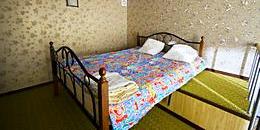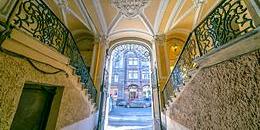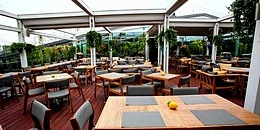Isaakievskaya Ploshchad (St. Isaac's Square)
St. Isaac's Square has long been one of the main public spaces of St. Petersburg. Some of the greatest works of Russian architecture of the 19th and 20th centuries are located here, including St. Isaac's Cathedral, the Mariinsky Palace, the Hotel Astoria and the Hotel Angleterre. Also, because of the location of the city's Legislative Assembly within the Mariinsky Palace, it has the unofficial status as the main administrative area of St. Petersburg.

The history of this square began in the 1730s and 40s. The area was originally assigned for trading, with a marina planned on the Moyka, warehouses along Bolshaya Gostinaya Ulitsa, and stalls selling salt along Voznesensky Prospekt. However, in the 1760s more grandiose structures began to appear in the area. On the south side of the square the Palace of Field Marshal Ivan Chernyshev was built beyond the Moyka River. On the north side, St. Isaac's Cathedral was reconstructed to designs by Antonio Rinaldi - this was the third cathedral in the area, the first having been adapted from one of the original warehouses. In fact, the "eternal construction" of St. Isaac's Square lasted around one hundred consecutive years.
In 1796, after the death of Catherine II, Emperor Paul ordered the transfer of all the marble from the project to the construction of the Mikhailovsky Castle. As a result St. Isaac's Cathedral was finished with clay brick and the unimpressive structure was received poorly. In 1816, Alexander I commissioned Auguste de Montferrand to erect a new temple. Forty years later the temple was complete. Urban legend has it that Montferrand predicted he would die soon after the temple was complete and deliberately dragged out the construction. This, in the end, is exactly what happened. However, the time and effort shows through, and St. Isaac's Cathedral is the fourth tallest cathedral in the world after the Basilica of St. Peter in Rome, St. Paul's Cathedral in London, and St. Mary's Cathedral in Florence.

In 1839-1844, Russian court architect Andrey Stackenshneider was commissioned by Nicolas I to build the magnificent Mariinsky Palace for his daughter Maria. At the same time, the Blue Bridge spanning the Moyka was extended to 99 meters, making it the widest bridge in St. Petersburg. A large portion of the bridge is incorporated within St. Isaac's Square and can go unnoticed. In the years 1856-1859, an equestrian monument to Nicholas I was erected in the center of the square. The statue's engineering is unique due to the fact that the rearing horse's feet are the only two points of support for the entire sculpture.
In the beginning of the 20th century, the diverse architectural ensemble of St. Isaac's Square began to be filled with new styles. In the south-eastern side of the square, the Hotel Astoria, an excellent example of St. Petersburg Art Nouveau, was built by the architect Fyodor Lidval. At around the same time on the opposite side of the square a new German Embassy was designed by the distinguished German architect and industrial designer Peter Behrens. This building's muscular neoclassicism was widely criticized at the time, but proved a prototype for what became the official architectural style of the Soviet Union under Joseph Stalin (the building was also purportedly greatly admired by Adolf Hitler).

In 1923 the square was renamed after one of the first Soviet diplomats, Vaclav Vorovsky, assassinated that year by a White emigre terrorist at the Conference of Lausanne, but in 1944 it returned to its historic name. During the Siege of Leningrad, a kitchen garden was laid out in the center of the square where vegetables were grown to feed the inhabitants of the war-torn city.
It is important to note that during its existence St. Isaac's Square has repeatedly been victim to St. Petersburg floods, as its location is close to the narrowest part of the Neva River. At such times, St. Isaac's Cathedral often became an island in a sea of water. Consequently in 1971, on the Moyka Embankment next to the Blue Bridge a "scale of Neptune" was installed - an obelisk that records the levels of major urban floods.
Today, the colonnade of St. Isaac's Cathedral offers a superb panoramic view of the square and all of downtown St. Petersburg.
| Metro stations: | Admiralteyskaya |
|---|---|
| Directions: | On exiting the metro, turn left and then left again at the end of the street onto Malaya Morskaya Ulitsa. Walk along the street around 300 m to reach the square. |
| What's here? | St. Isaac's Cathedral, Mariinsky Palace, Hotel Astoria, Monument to Nicholas I, Horse Guards Riding School, Miller Mansion, Zubov Mansion, Myatlev House, German Embassy Building, Blue Bridge |
| What's nearby? | Moyka River, Bolshaya Morskaya Ulitsa, Voznesensky Prospekt, Alexander Garden, Malaya Morskaya Ulitsa |










